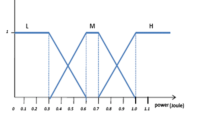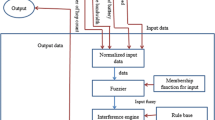Abstract
The Mobile ad hoc wireless network is infrastructure less mobile network that allows communication among several mobile devices. The energy and delay of each mobile node affect the network performance in higher load. So, it becomes important to take into account these factors during the path selection. Here, we propose a method to incorporate the concept of fuzzy logic system to existing AODV routing protocol, and to select the optimal path by considering the remaining energy and delay of each node along with hop count. The experiment result shows that the proposed fuzzy-based modify-AODV (M-AODV) routing protocol outperforms the existing AODV in terms of average end-to-end delay and packet delivery ratio.
Access provided by Autonomous University of Puebla. Download conference paper PDF
Similar content being viewed by others
Keywords
1 Introduction
In recent years due to technologies advancement in real-time application like communication in battlefield, disaster management, civil, open construction, and urgent meeting at open place, etc. attracted more attention from academia and industry. The ad hoc network is classified into twofold: infrastructure and infrastructure less. Infrastructure less wireless network consists of base stations which are linked with each other. Communication among mobile nodes takes place via those base stations. An infrastructreless ad hoc is also called as Mobile ad hoc network and applicable in above said areas. Mobile ad hoc network comprises of number of mobile nodes that do not use infrastructure and dynamically form temporal wireless network among them. Each node acts as a router and is capable of dynamic discovery of routes, recover link automatically and movement of nodes [1–3]. The mobile nodes can perform the basic network functions such as routing, forwarding, and service discovery. Communication among nodes in MANETS has constraints of energy, bandwidth and link stability, etc. Therefore, all these constraints should be considered for efficient design of the routing protocols for ad hoc networks. In different environment applications, the ad hoc networks possess different network topology and characteristics. Strength of traffic, network topology, energy consumption, and delay are highly dependent on application environments, and hence, these become important parameters from the routing protocols performance view point. Therefore, the protocol parameters should be configured dynamically in different network environments. To improve the protocol performance, these dynamical configurations should be adapted in the varying of the network topology. Earlier, the MANET’s AODV routing protocol only considered hop count as metric and thus not provide optimal solution in some application.
The process of each node in MANET depends on available energy. Due to limited size and battery capacity, the energy of each node is limited and thus, it becomes important metric for designing an energy-efficient routing protocol. Communication among mobile nodes is also affected by Delay. In high mobility model end-to-end delay also affects the routing decision. In real-time Scenario, these two factors affect the routing decision. We propose a fuzzy logic-based algorithm for mobile ad hoc networks, which not only considers hop count but also consider remaining energy of each node and delay between the nodes while taking routing decision. The simulation results confirm the merit of our proposed method as compare to traditional AODV.
The remainder of this paper is organized as follows: Existing related research work is described in Sect. 2. The description of the proposed method is depicted in Sect. 3. Section 4 presents the performance of the proposed method, while conclusions are drawn in Sect. 5.
2 Related Work
Due to node movement in dynamic nature of MANETs, there are chances of route breakage. Therefore, the nodes those are more stable in nature to be considered while selecting the route path. Zing et al. [4] proposed a novel FL-DSR protocol which considered inputs metric hop count together with the route life time for choosing the route which has highest route stability. The performance of FL-DSR was better than traditional DSR, because it had lesser number of route break events, improved network throughput, while minimizing control load of the network. During high load, some of nodes are lighter as compare to other nodes in the network and thus it affects the system performance. To balance the network, the load to be evenly distributed. Song [5] integrated the fuzzy logic system to conventional DSR called MQRFT that selecting the optimal route by considers the network status information like link bandwidth available (LBA), link signal strength (LSS), and buffer occupancy ratio (BaR) as input metric to fuzzy logic system. Michele et al. [6] proposed a fuzzy logic-based method to select improved paths and increased lifetime of the network. Nie et al. [7] proposed the security-level (FLSL) routing protocol based on fuzzy logic that selects the routes with highest security.
3 Fuzzy Systems
The working of Fuzzy inference system [8, 9] consists of following steps: (1) selection of input and output linguistic variable, (2) Fuzzification, (3) inference engine, (4) system rule base, and (5) defuzzification. The process of fuzzification transforms crisp input values into membership values of the fuzzy set. Then, inference engine calculates the fuzzy output using the rule base and finally, the fuzzy output is converted into crisp values by the defuzzification process. The summary of fuzzy system is described in Fig. 1.
3.1 Modify-AODV (M-AODV)
In AODV, when a node wants to communicate with other node, in order to find a path, it broadcasts a RREQ packet to the network.
Here, we propose a routing decision method to decide whether a node will appear in the path to continue or not. Route metrics that make the routing decision are available remaining energy at participating node, hop count and end-to-end delay between nodes. Three linguistic variables for inputs are: low, medium, and high. Five linguistic variables for outputs are very low, low, medium, high, and very high, where each one is assigned a value between {0,1}. Triangle membership’s function is used to represent the output and input. Fuzzy inference engine applies a set of fuzzy rules on theses evaluations to obtain the desired behavior of the system as shown in Table 1.
Because the route discovery process of AODV is broadcast in nature, the RREQ packet of AODV carries the fuzzy input parameter: hop count, delay, energy. Each node embedded a fuzzy logic system that dynamically evaluates the fuzzy cost each time when RREQ packet arrives. If it finds path with lesser fuzzy cost then it is chosen and update reverse route entry. This process is continued until the packet arrives at the destination. Unsuitable paths are removed from the route discovery process and performance of the routing protocol is optimized. Paths which have a large associated signal loss, higher hop count, and nodes which contain lesser amount of energy are classified as unstable paths.
The proposed algorithm is described as follows:
-
1.
For each node Ni, fetch following parameters:
hop count hi,
delay di, and
energy factor ei on arrival of RREQ packet.
-
2.
Next, we calculate the fuzzy cost fci for each node Ni.
-
3.
If New fci is < stored fci of that node,
then update the reverse route entry table.
end of if loop.
-
4.
If the node is Destination, forward the RREQ packet to source from current route.
-
5.
Otherwise go to step 1.
4 Simulation Result
4.1 Simulation Parameters
In this section, we evaluate the performance of the proposed M-AODV protocol and compare with traditional AODV. We consider packet delivery ratio and delay as performance metrics. Packet delivery ratio is defined as the ratio of data packets reaching the destination node to the total data packets generated at the source node, while delay metric is defined as the average of the difference in time between the destination node and the source node. This difference includes the processing time and queuing time. The simulation parameter for M-AODV is considered as described in Table 2. In this simulation, nodes in the networks are set to 30 and are placed within a 700 m × 700 m area. The transmission range of the nodes is 250 m. We used random waypoint model with node speed ranges from 0 to 10 mps. The traffic pattern consisted of CBR traffic type which generates UPD packets from available nodes. The UDP packet size is 512 bytes. The network simulator NS2.35 is used for simulating the proposed M-AODV. In addition, the MATLAB is used to simulate fuzzy cost using fuzzy logic toolbox. Next, the MATLAB receives the input parameter from the NS2 and processes to produce the results which are feedback to NS2 to help NS2 in making routing decision.
Figure 2 Compares the packet delivery ratio of M-AODV routing protocol and traditional AODV routing protocol for 30 nodes. We varied simulation time from 50 to 250 s. From the Fig. 2, we can observe that M-AODV can achieve higher packet delivery ratio as compared with traditional AODV due to stable path selection.
In Fig. 3, we compare the average end-to-end delay of the M-AODV with traditional AODV routing protocol. It can be observed that the average end-to-end delay of M-AODV reduces to a level that is slightly lower than that of original AODV.
5 Conclusion
In this paper, we proposed the existing AODV routing protocol and proposed M-AODV which are available to find more stable path for communication. Further, we compared this protocol’s performance with well-known AODV. Our simulation was carried out using NS2.35 simulator and dynamically fuzzy cost is calculated based on metrics hope count, delay and remaining energy using MATLAB Fuzzy logic toolbox. The simulation results show that M-AODV performed better than existing AODV routing protocol in terms of packet delivery ratio and delay.
References
Murthy, C.S.R., Manoj, B.S.: Ad Hoc Wireless Networks: Architecture and Protocols. Pearson Ltd (2004)
Sharma, V., Alam, B.: Unicaste routing protocols in mobile ad hoc networks: a survey. Int. J. Comput. Appl. USA 51, 148–153 (2012)
Leo Manickam, J.M., Shanmugavel, S.: Fuzzy based trusted ad hoc on-demand distance vector routing protocol for MANET. In: 3rd International Conference on Wireless and Mobile Computing, Networking and Communications (2007)
Zuo, J., Xin Ng, S., Hanzo, L.: Fuzzy logic aided dynamic source routing in cross-layer operation assisted ad hoc networks. In: 72nd IEEE Conference on Vehicular Technology, pp. 1–5 (2010)
Song, W., Fang, X.: Multi-metric QoS routing based on fuzzy theory in wireless mesh network. In: IET International Conference on Wireless, Mobile and Multimedia Networks, pp. 1–4 (2006)
Lima, M.N., da Silva, H.W., Dos Santos, A.L., Pujolle, G.: Survival multipath routing for MANETs. In: IEEE Conference on Network Operation and Management Symposium, pp. 425–432 (2008)
Nie, J., Wen, J., Luo, J., He, X., Zhou, Z.: An adaptive fuzzy logic based secure routing protocol in mobile ad hoc networks. Fuzzy Sets Syst. 157(12), 1704–1712 (2006)
Torshiz, M.N., Amintoosi, H., Movaghar, A.: A fuzzy energy-based extension to AODV routing. International Symposium on Telecommunications, pp. 371–375 (2008)
Ross, T.J.: Fuzzy logic with Engineering Application. McGraw Hills Inc., New York, (1995)
Author information
Authors and Affiliations
Corresponding author
Editor information
Editors and Affiliations
Rights and permissions
Copyright information
© 2016 Springer India
About this paper
Cite this paper
Sharma, V., Alam, B., Doja, M.N. (2016). Fuzzy-Based M-AODV Routing Protocol in MANETs. In: Satapathy, S., Raju, K., Mandal, J., Bhateja, V. (eds) Proceedings of the Second International Conference on Computer and Communication Technologies. Advances in Intelligent Systems and Computing, vol 380. Springer, New Delhi. https://doi.org/10.1007/978-81-322-2523-2_75
Download citation
DOI: https://doi.org/10.1007/978-81-322-2523-2_75
Published:
Publisher Name: Springer, New Delhi
Print ISBN: 978-81-322-2522-5
Online ISBN: 978-81-322-2523-2
eBook Packages: EngineeringEngineering (R0)







